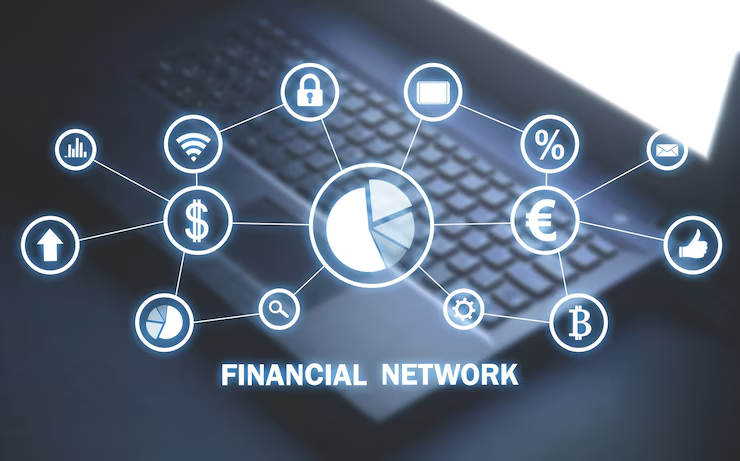Introduction to Blockchain Technology in Banking
What is Blockchain Technology?
Blockchain Technology in Banking 2025: The decentralized digital ledger known as blockchain technology keeps track of transactions on several computers.
Blockchain Technology in Banking 2025
It ensures transparency, security, and immutability of data, making it ideal for sensitive industries like banking.
Why is Blockchain Important for Banking?
Banks handle vast amounts of data daily, including sensitive customer information and financial transactions. Blockchain’s secure and transparent nature reduces fraud risks, streamlines processes, and builds customer trust.
Evolution of Blockchain in Banking
From its origins in cryptocurrency, blockchain has evolved into a versatile tool for financial institutions. Initially met with skepticism, banks now recognize its potential to revolutionize how they operate.

Core Features of Blockchain Revolutionizing Banking
Transparency and Security Blockchain Technology in Banking 2025
How Blockchain Enhances Transparency: Every transaction is recorded on a shared ledger, accessible to all participants in real-time. This eliminates discrepancies and ensures trust.
The Role of Cryptographic Security: Blockchain uses advanced encryption methods, making data tampering almost impossible.
Decentralization in Financial Systems
Blockchain eliminates the need for intermediaries like clearinghouses, speeding up transactions and reducing costs.

Cost Efficiency for Banks and Customers
Automating processes with blockchain reduces operational costs for banks, leading to lower fees for customers.
Current Applications of Blockchain in Banking
Cross-Border Payments Blockchain Technology in Banking 2025
- Faster and Cheaper Transactions: Blockchain reduces the time for international transfers from days to minutes, saving on hefty fees.
- Real-World Examples of Blockchain Payments: Ripple and Stellar are already partnering with banks to facilitate efficient cross-border payments.
- Fraud Prevention and Risk Management
By creating an immutable record of transactions, blockchain reduces fraud risks and enhances the integrity of financial systems.

Smart Contracts in Banking
Smart contracts are self-executing agreements with predefined conditions. They automate processes like loan approvals, ensuring efficiency and reducing errors.
Digital Identity Management
Blockchain securely stores customer identities, simplifying Know Your Customer (KYC) procedures while ensuring privacy.

Blockchain and Banking in 2025: A Vision of the Future
The Rise of Central Bank Digital Currencies (CBDCs) Blockchain Technology in Banking 2025
Governments worldwide are exploring CBDCs, leveraging blockchain to create secure and efficient digital currencies.
Fully Automated Banking with Blockchain
In 2025, blockchain could enable entirely automated systems, minimizing human intervention and errors.
Enhanced Customer Experience
With faster processes and reduced costs, customers will enjoy seamless banking experiences.

Integration with Artificial Intelligence (AI) and IoT
Blockchain, combined with AI and IoT, will enable predictive analytics and smarter financial solutions.
Challenges and Limitations
Scalability Issues Blockchain Technology in Banking 2025
It can be difficult for blockchain networks to swiftly process high transaction volumes.
Regulatory and Compliance Barriers
Governments worldwide are still working to standardize blockchain regulations, posing a challenge for global banks.
Adoption Hesitancy Among Banks
Traditional banks may be slow to adopt blockchain due to unfamiliarity and perceived risks.
Solutions to Blockchain Challenges
Layer 2 Solutions and Scalability Enhancements
Innovations like Layer 2 protocols (e.g., Lightning Network) can address scalability issues.
Harmonizing Regulations Across Countries
Global cooperation is essential to create unified blockchain regulations.
Educating Stakeholders and Building Trust
Banks must invest in training programs and awareness campaigns to ease adoption.
Real-Life Case Studies Blockchain Technology in Banking 2025
Case Study: Ripple and Santander
Ripple’s technology powers Santander’s One Pay FX, enabling instant international payments.
Case Study: JPMorgan’s Blockchain Initiative
JPMorgan’s Onyx network uses blockchain to streamline payments and trading.
Case Study: Digital Identity Verification Using Blockchain
Blockchain-based digital IDs simplify and secure customer verification processes.
Blockchain’s Impact on Banking Jobs
New Roles and Skill Requirements Blockchain Technology in Banking 2025
Blockchain adoption creates demand for tech-savvy professionals skilled in blockchain development and cybersecurity.
Automation and the Shift in Workforce Dynamics
While some traditional roles may become obsolete, new opportunities will emerge in managing blockchain systems.
Environmental Impact of Blockchain in Banking
Addressing Energy Concerns Blockchain Technology in Banking 2025
The banking industry is exploring energy-efficient blockchain networks to reduce environmental impact.
Transition to Eco-Friendly Blockchain Networks
Efforts like Ethereum’s shift to proof-of-stake demonstrate a commitment to greener solutions.
Conclusion
Blockchain technology is undeniably a game-changer for the banking sector. By 2025, its integration will transform how banks operate, offering faster, more secure, and customer-friendly services. While challenges remain, innovative solutions and global cooperation are paving the way for a blockchain-driven future.
FAQs
1. What is the role of blockchain in preventing fraud?
Blockchain creates an immutable record of transactions, making fraud nearly impossible.
2. How does blockchain improve cross-border payments?
It speeds up transactions, reduces costs, and eliminates intermediaries, making international payments more efficient.
3. Are there risks in adopting blockchain for banks?
Yes, challenges include scalability issues, regulatory uncertainties, and initial adoption costs.
4. Will blockchain eliminate traditional banking jobs?
While some roles may evolve or disappear, new opportunities will arise in blockchain-related fields.
5. How can banks prepare for blockchain adoption?
Banks can invest in training, collaborate with tech firms, and explore pilot projects to integrate blockchain.




